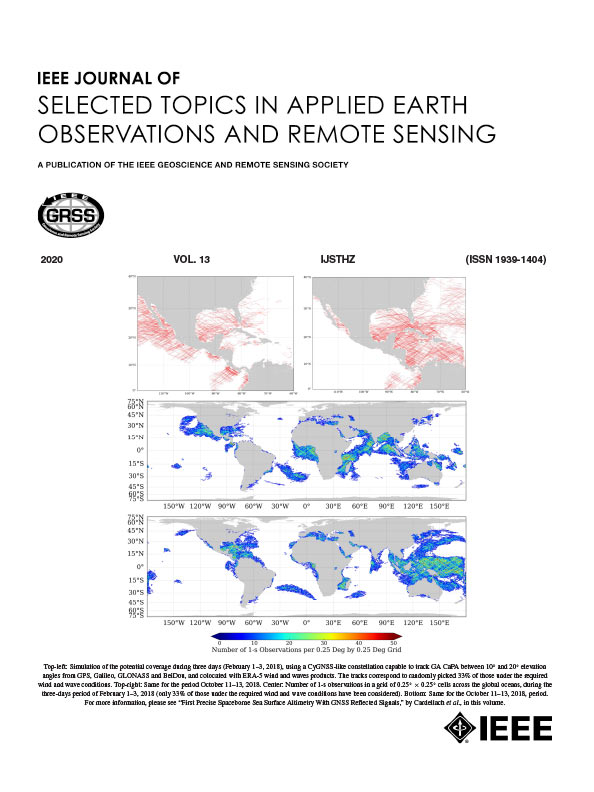Satellite Image Inpainting With Edge-Conditional Expectation Attention
IF 4.7
2区 地球科学
Q1 ENGINEERING, ELECTRICAL & ELECTRONIC
IEEE Journal of Selected Topics in Applied Earth Observations and Remote Sensing
Pub Date : 2025-04-09
DOI:10.1109/JSTARS.2025.3559203
引用次数: 0
Abstract
Satellite images often suffer from data loss and corruption due to various factors, including sensor malfunctions and atmospheric interference, leading to incomplete and degraded imagery. In satellite images, long-range dependencies are particularly significant due to irregular and widely distributed geomorphological edges, such as rivers, mountains, and urban structures. Traditional convolutional neural network-based inpainting methods face challenges due to their fixed receptive fields and parameter sharing, limiting their ability to effectively capture long-range dependencies and differentiate between corrupted and uncorrupted areas. To address these limitations, we propose a deep learning approach based on an edge-conditional expectation attention module, which conditions the attention mechanism on edge information to enhance the model's focus on high-frequency edge details. This enables the network to capture critical structures within the image better. In addition, we apply Chebyshev’s inequality within the attention mechanism to constrain the expectation of attention outputs, reducing excessive deviations and stabilizing the reconstruction process. Experimental results demonstrate that our approach outperforms several state-of-the-art methods in restoring missing regions and reconnecting geomorphological features.边缘条件期望注意的卫星图像绘制
由于各种因素,包括传感器故障和大气干扰,卫星图像经常遭受数据丢失和损坏,导致图像不完整和退化。在卫星图像中,由于不规则和广泛分布的地貌边缘,如河流、山脉和城市结构,远程依赖关系尤为重要。传统的基于卷积神经网络的修复方法由于其固定的接受域和参数共享而面临挑战,限制了它们有效捕获远程依赖关系和区分损坏和未损坏区域的能力。为了解决这些限制,我们提出了一种基于边缘条件期望注意力模块的深度学习方法,该方法将注意力机制限制在边缘信息上,以增强模型对高频边缘细节的关注。这使得网络能够更好地捕获图像中的关键结构。此外,我们在注意机制中应用Chebyshev不等式来约束注意输出的期望,减少过度偏差,稳定重建过程。实验结果表明,我们的方法在恢复缺失区域和重新连接地貌特征方面优于几种最先进的方法。
本文章由计算机程序翻译,如有差异,请以英文原文为准。
求助全文
约1分钟内获得全文
求助全文
来源期刊
CiteScore
9.30
自引率
10.90%
发文量
563
审稿时长
4.7 months
期刊介绍:
The IEEE Journal of Selected Topics in Applied Earth Observations and Remote Sensing addresses the growing field of applications in Earth observations and remote sensing, and also provides a venue for the rapidly expanding special issues that are being sponsored by the IEEE Geosciences and Remote Sensing Society. The journal draws upon the experience of the highly successful “IEEE Transactions on Geoscience and Remote Sensing” and provide a complementary medium for the wide range of topics in applied earth observations. The ‘Applications’ areas encompasses the societal benefit areas of the Global Earth Observations Systems of Systems (GEOSS) program. Through deliberations over two years, ministers from 50 countries agreed to identify nine areas where Earth observation could positively impact the quality of life and health of their respective countries. Some of these are areas not traditionally addressed in the IEEE context. These include biodiversity, health and climate. Yet it is the skill sets of IEEE members, in areas such as observations, communications, computers, signal processing, standards and ocean engineering, that form the technical underpinnings of GEOSS. Thus, the Journal attracts a broad range of interests that serves both present members in new ways and expands the IEEE visibility into new areas.

 求助内容:
求助内容: 应助结果提醒方式:
应助结果提醒方式:


